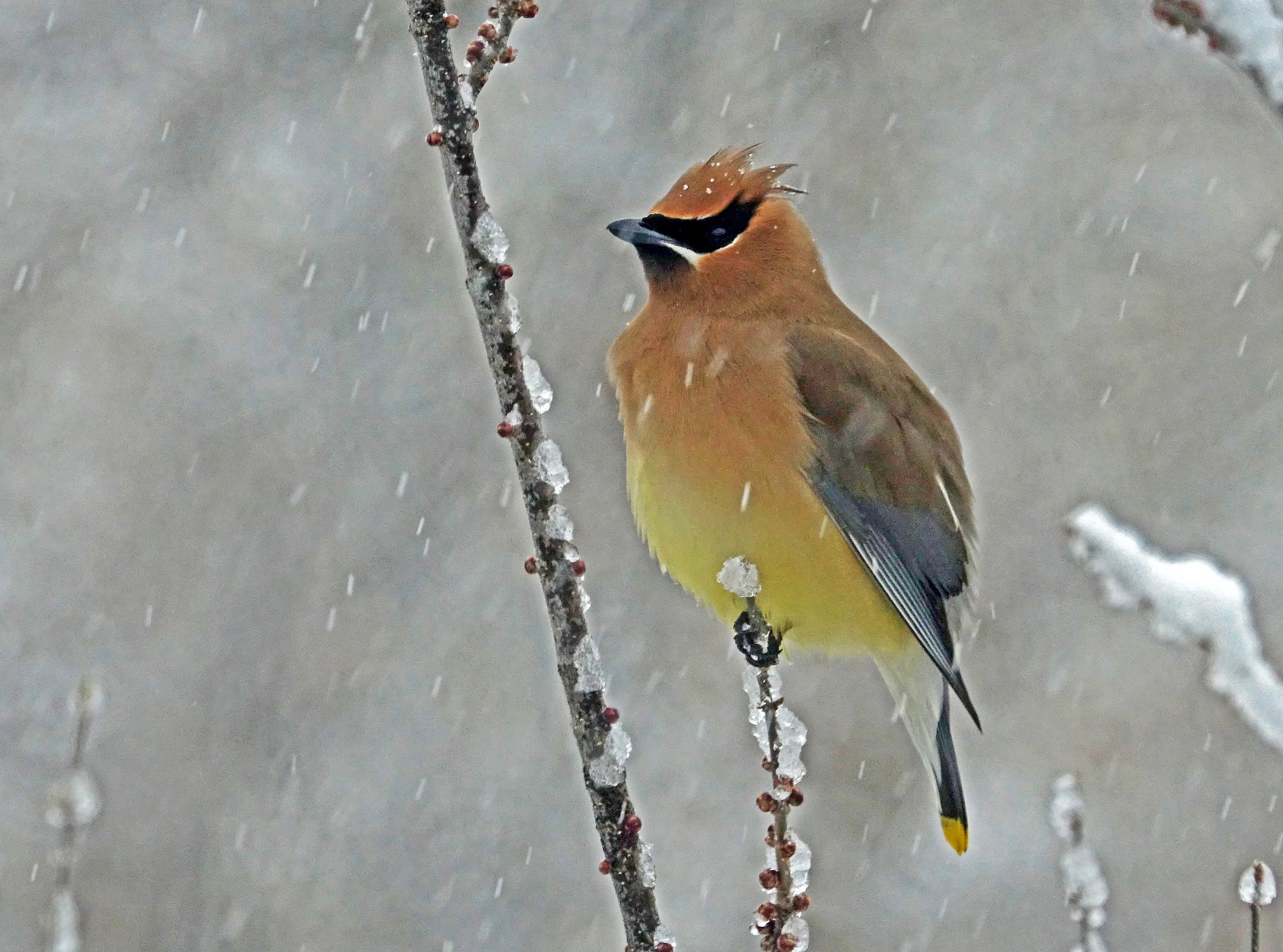December Nature Almanac: Cedar Waxwings Embrace Suburban Life
by Stephen Jones and Ruth Carol Cushman
December 2021
When we first settled in Boulder more than a half-century ago, we would have been startled and thrilled to see a Cedar Waxwing in our backyard. These gregarious fruit-eaters were considered "eastern birds", more likely to thrive in deciduous woodlands of the Midwest and New England than in semi-arid western landscapes. Now we see or hear them throughout the year -- flocking to junipers, dangling from berry-laden mountain ashes, or visiting our backyard bird feeders. And is there a bird that's more welcome in our backyards than a cedar waxwing?
Cedar waxwings get their name from the eastern red cedars, where they nest and forage for berries, and from the red waxy tips of the secondary feathers of their wings. The spread of red cedars across the Great Plains has helped these waxwings expand their breeding range westward. Photo by Stephen Jones.
With their swept-back crests, coal-black facial masks, the yellow trailing edge of the tail, and jewel-like waxy, red tips on their wing feathers, these songbirds look like the creation of a fashion designer. Their behavior seems equally artful as they flit from one berry-laden branch to another, trilling softly and occasionally passing ripe berries from one beak to another.
We've seen 100 or more closely-related Bohemian Waxwings descend on a fruiting juniper and form virtual berry brigades. This behavior may cement social bonds while also enabling the feeding waxwings to ward off competing solitaires and robins.
If Cedar Waxwings watched television, their favorite show might be Ozzie and Harriet, because the suburbanization of North America has actually helped make their lives so fruitful. The proliferation of mountain ashes, junipers, pyracanthas, chokecherries, and other fruit-bearing trees and shrubs in suburban neighborhoods has enabled Cedar Waxwings to expand their breeding and wintering ranges westward across the continent.
Partners in Flight estimates a current global breeding population of 52 million, with 70% spending at least part of the year in the United States, 55% in Canada, and 18% in Mexico. Numbers are stable or increasing throughout much of their range. Collisions with cars and windows are a primary cause of mortality for these urban-adapted fruit-eaters. Feral and outdoor house cats take a significant toll, as well.
Bohemian Waxwings, forest dwellers who roam over thousands of miles searching for wild fruits, aspen leaf-roller caterpillars, and other favored foods, don't appear to be doing so well. North American breeding bird survey data suggest that their North American numbers have declined 55% since 1970, and Partners in Flight estimates their total world breeding population at only 4.6 million. Poisoning from pesticides sprayed on fruits, along with window collisions, appear to cause significant mortalities.
Cedar Waxwings can subsist on fruit, alone, for months at a time. In summer they supplement their fruit diet with protein-rich insects often caught on the wing.
For nesting, the female typically chooses the fork of a horizontal branch located anywhere from 3 to 50 feet off the ground. Pairs gravitate toward trees and shrubs with dense, protective leaf growth, including junipers (also known as red cedars), bur oaks, and hawthorns. Though Brown-headed Cowbirds can find waxwing nests and dump their eggs in them, their offspring usually die from the effects of being fed way too much fruit.
In late summer and fall, people sometimes report seeing "drunk" waxwings in their backyards. This irregular behavior often results from consumption of fermenting, overripe berries. During the past few decades, people have noticed waxwings with orange instead of yellow tail tips. The unusual orange coloration develops when a form of red pigment, different from that in native species, is absorbed when consuming fruit from an introduced species of honeysuckle popular in many gardens.
This adult Cedar Waxwing seemed content perching on a bare green-ash branch during a December snowstorm. Photo by Stephen Jones.
In many ways, Cedar Waxwings would qualify as urban-adaptive generalists, whose ability to subsist on a variety of fruits has enabled them to benefit from human disturbance of native ecosystems. But while some may shudder at the proliferation of crows, rock pigeons, starlings, and house sparrows in our suburban neighborhoods, it's unlikely that many birdwatchers would bemoan the midwinter sight of a group of colorful, gregarious waxwings trilling their way from one snow-flocked fruit tree to another.
Other December Events
Early Easter daisies have begun blooming on south-facing shales in the foothills.
Due to the unusually warm conditions in November, some cottonwoods on the plains have miraculously retained their mostly-green leaves. If you see any of these winter pioneers in December, please let us know.
Snow Geese and Greater White-fronted Geese gather on ice-free areas of prairie reservoirs. To see them, try Dodd Reservoir, north of IBM and west of 95th St., or Union Reservoir, east of Longmont.
The earliest sunset of the celestial year occurs around December 7, whereas the latest sunrise won't occur until January 6, giving us a month to celebrate the miracle of Winter Solstice. This year's Winter Solstice sunrise hike on White Rocks Trail will take place on December 21. Dress warmly and meet at the North Teller Farms parking area on Valmont Road at 7 AM.
Stephen Jones and Ruth Carol Cushman are authors of The North American Prairie and Wild Boulder County.


